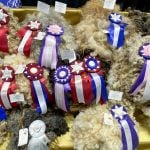SASKATOON, Sask. – A disease which gives calves a Jay Leno smile and leaves them so crippled they can only sit like dogs has been linked to mouldy straw, said a University of Saskatchewan veterinarian.
It took “cowboy logic” and years of head scratching to finally link congenital spinal stenosis with mouldy straw, said Eugene Janzen of the Western College of Veterinary Medicine.
“All of the CSS calves came from a group that were fed predominantly straw during the winter,” Janzen told researchers and chemical and feed company representatives during a Western Nutrition Conference held here last week.
Read Also

Short rapeseed crop may put China in a bind
Industry thinks China’s rapeseed crop is way smaller than the official government estimate. The country’s canola imports will also be down, so there will be a lot of unmet demand.
Variety of poisons
Janzen said the tragic disease is likely caused by a “cocktail of toxins” which form mould on the straw.
A precise set of circumstances is required for the disease to develop.
In all farms studied, straw bales got extremely wet and then very hot from warm fall weather. Yet they weren’t obviously contaminated by mould. In one case it looked like the straw had black spots, each about half the size of a finger nail. Another farmer’s straw looked like it had been sprinkled with pepper.
Calving problems
Cows with the disease usually lose their hair in January, have difficulty calving and develop dysentery.
Calves from these cows usually have shortened front limbs and can do nothing but sit like dogs when their spinal canal stops growing prematurely and pinches their spinal cord.
“There is serious constriction in the nervous tissue,” Janzen said.
“It tears your heart out to know none of these calves can get up.”
Calves as large as 400 pounds will collapse and can only drag themselves about in a circle. “The older calf’s cry is awful distressing,” Janzen said.
Another symptom is a domed head with a protruding jaw, leading farmers to name the symptom the Jay Leno smile. It’s not uncommon for all calves from diseased herds to die.
While no toxicology proof has been found, Janzen believes the fungus remains in the soil or environment and appears when warm, wet conditions are ideal.
Once the cows are taken off the mouldy feed they completely recover.














